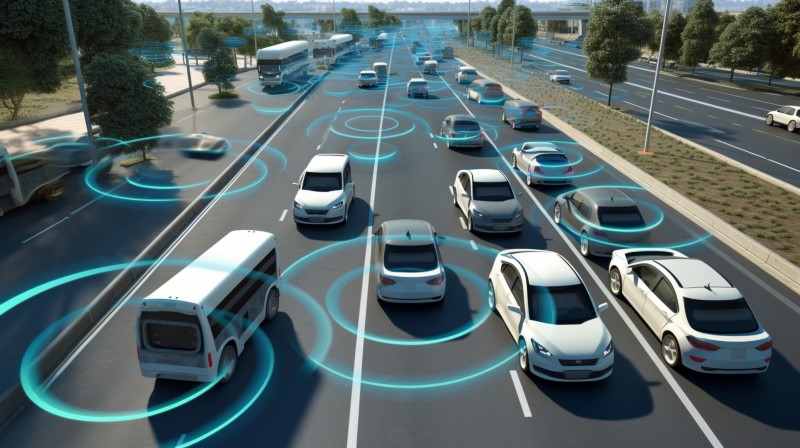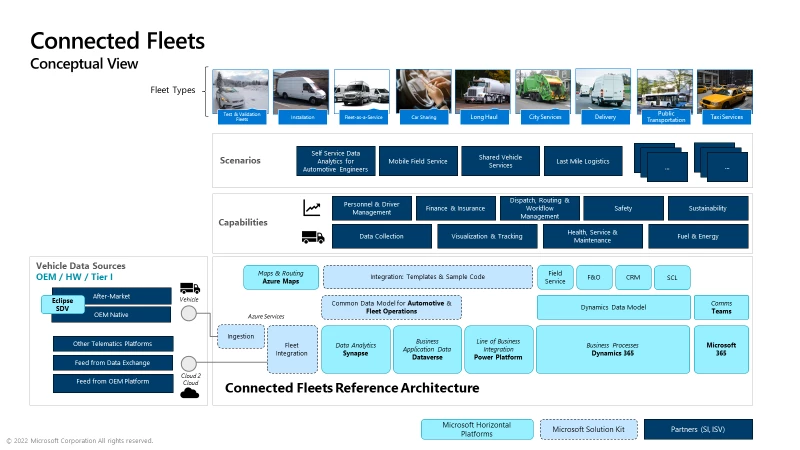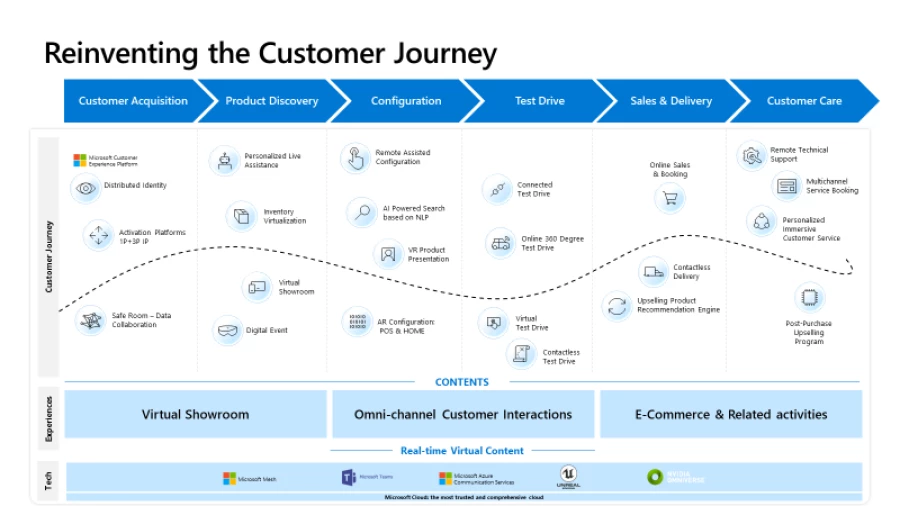
Microsoft automotive, mobility, and transportation reference architectures: Rapidly deploy solutions to drive your transformation
Businesses today are increasingly faced with the challenge of innovating while doing more with less, and this is especially true in automotive, mobility, and transportation. This challenge is one where the right technology can help drive transformation—and deliver more value in less time.
Supporting these objectives, Microsoft has created reference architectures that enable its partner ecosystem to help customers drive the future of mobility across research and development, manufacturing, supply chain and logistics, marketing, sales, and aftersales.
These reference architectures are designed to provide the structure and guidance needed for project managers, enterprise architects, and IT managers to deliver agile business outcomes.
Solutions utilizing the following automotive, mobility, and transportation industry reference architectures are available through qualified partners.

Transform to smart mobility
Discover how Microsoft is helping to accelerate the transformation of automotive, mobility, and transportation companies.
Microsoft Connected Fleets reference architecture
The Microsoft Connected Fleets reference architecture enables faster, lower cost, higher value fleet management solutions—such as asset management and field service—by simplifying value extraction from connected vehicle data, streamlining integration with business systems, and facilitating specialized analytics.
This reference architecture utilizes a framework based on the Microsoft Common Data Model. Connected Fleets thus enables partners to build value-added solutions with unique capabilities, while also enabling the customer to take advantage of key Microsoft solutions such as Microsoft Azure, Microsoft Dynamics 365, and others. This eliminates the need for fractured solutions built from multiple sources, allows faster development and time to value, and can utilize the Microsoft Cloud to reduce costs. With flexible, Microsoft Azure Internet of Things (IoT) based data ingestion, the architecture supports existing connected vehicle solutions, original equipment manufacturer (OEM) feeds, or data exchanges as appropriate. This flexibility helps to reduce the overall cost of vehicle data acquisition.
With a focus on fleet customers, mobility service providers, and emerging or smaller OEMs, the Microsoft Connected Fleets reference architecture is enabled by the following partners where additional value-added capabilities are provided:

Microsoft Autonomous Vehicle Operations (AVOps) reference architecture
The Microsoft AVOps reference architecture provides a comprehensive set of cloud, edge, vehicle, and AI services that enable an integrated, end-to-end workflow for developing, verifying, and improving automated driving (AD) functions. This autonomous development workflow will be supported by partners utilizing the Microsoft Cloud. These capabilities are helping our customers accelerate time-to-market for new autonomy capabilities.
Our first-party and partner solutions create a strong, industry-vetted toolchain that spans the various stages of development, validation, runtime deployments, and feedback loops.
We provide industry-leading Microsoft Azure Cloud services to plug and play in the toolchain while our partners provide tightly integrated capabilities to enable the much-needed, global, secure, and hyper-scale cloud-based development platform for advanced driving assistance systems (ADAS) and autonomous vehicles (AVs).
Regardless of the level of autonomy, developing an autonomy stack and bringing a new car to market presents a series of workflow challenges:
- Fleets of test vehicles generate petabytes (PBs) of data daily. How do you extract it efficiently and inexpensively?
- Every single software and AI update requires validation through simulation with massive amounts of computing.
- PBs of data and petascale computing is expensive—delivering on time and under budget is challenging.
- How do you accurately validate and test performance?
The Microsoft AVOps reference architecture provides a templatized digital testbed that can be spun up on demand, shared across the entire value chain, and shorten time-to-market across any security operation center (SoC) companies to provide systems-level parity. This approach fundamentally helps our automotive customers and partners transform themselves into software and AI companies.
The Microsoft AVOps reference architecture is also focused on optimizing operational end-to-end ADAS and AV workflow coordination and feature development, verification, and validation by integrating and scaling:
- DataOps: From edge to cloud, the orchestration of PBs of data to support parallel workstreams.
- DevOps: Scaling the continuous integration (CI) and continuous delivery (CD) pipeline.
- MLOps: Scaling machine learning pipelines and integrating with CI and CD pipelines.
- ValidationOps: The ability to accurately simulate software and AI updates across all edge cases.
The Microsoft AVOps reference architecture provides a collaborative, open framework built on common processes that helps automate, manage, and closely monitor the validation processes for software and hardware deployment. The following Microsoft partners provide additional value-added capabilities to this framework:

Microsoft Digital Selling reference architecture
The Microsoft Digital Selling reference architecture enables the reinvention of the traditional customer journey by transforming real-life spaces into an immersive and interactive digital environment that reaches a wider range of customers.
The reference architecture enables unique, efficient, and immersive ways to engage with consumers by unlocking the power of the metaverse to improve communications, sales, and operations. Enhanced by partner capabilities, focus areas include digital marketing, eCommerce, high-fidelity 3D rendering, and industry-specific systems. By integrating disparate data from the customer, field service, and dealer management systems, improved visibility, collaboration, and data insights can drive more personalized, multi-channel customer experiences. Through the Digital Selling reference architecture, Microsoft Cloud, and partner capabilities, OEMs, dealers, and mobility service providers now have the flexibility to enhance in-person interactions along with enabling new digital customer engagement models.
This recent announcement by Fiat highlights the transformative impact of digital selling.
Microsoft is curating a group of expert partners that will drive innovation while providing excellence in omnichannel fulfillment, immersive and virtual user experiences, and end-to-end process coverage. The initial partners include:

Microsoft at CES 2023
We’re excited to share our vision for innovation at CES 2023 and encourage you to visit our booth #6017 in the Las Vegas Convention Center West Hall.
Learn more
To learn more about how Microsoft is accelerating the future of mobility, visit our website highlighting the automotive, mobility, and transportation industry.




